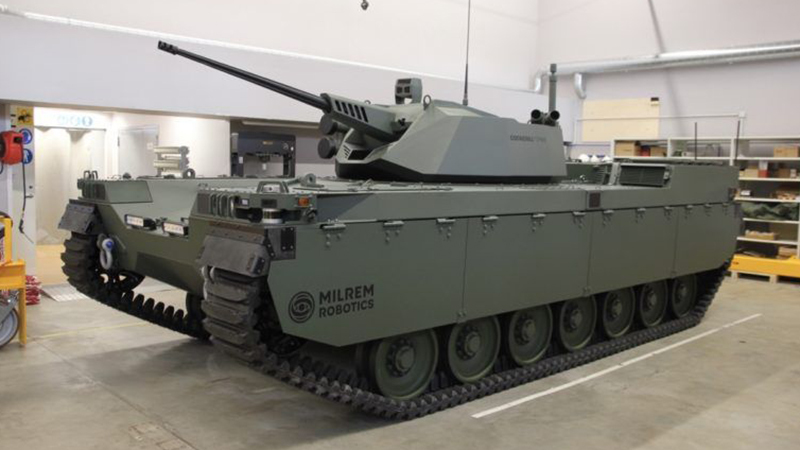

Image Courtesy: Milrem Robotics
The Defence and Security Equipment International (DSEI) exhibition has a history of showcasing the most cutting-edge military technology. This year’s event was no exception, as we saw autonomous combat vehicles take a prominent position.
But, this begs the question: is autonomy the future of warfare? Let us look at some of the most recent offerings to get a better idea.
Two autonomous vehicles showcased this year were the Type-X and the V60. The Type-X is a Robotic Combat Vehicle developed by Pearson Engineering and Milrem Robotics. In short, it is a robotic tank controlled through a combination of augmented AI and a remote operator.
On the surface, it looks like any normal tank, albeit a compact version. It weighs twelve tons, stands 2 metres tall, and has a top speed between 50 and 80 km/h depending on road conditions. The Type-X can take 25-50mm autocannons or a modified version of the Loitering Munitions System.
The Type-X will fulfil various combat roles, ranging from troop support to perimeter defence. It has GPS and an autonomous follow-me function, allowing it to support a convoy without human intervention.
The Ghost Robotics V60 is something else entirely. It looks like something from a sci-fi film and will fill the role of military dogs, but with greater functionality. For example, it can be fitted with a 5G mast to provide network coverage in remote battlefields.
Like the Type-X, it has remote-operation and autonomous functions. Currently, the V60 will fulfil disaster-relief and battlefield support vehicle roles for tasks such as detecting IEDs. Consultants on the project have stopped short of saying whether the V60 will ever be armed with weapons, but anything is possible.
There are clear benefits of using autonomous vehicles in warfare, particularly for high-risk situations. The purpose of the Type-X is to increase troop survivability by removing troops from the battlefield. If a tank can be operated remotely from a secure location, it lowers overall risk.
The same is true for the V60. It will fulfil the role of military dogs without putting animals in harmful situations. Along with this, it offers cost advantages because it lasts longer than a dog and requires far less upkeep. Autonomous vehicles arguably improve reliability and troop survivability while reducing cost in the long term.
However, there are clear ethical issues with autonomous warfare. Do we teach AI-controlled vehicles when to shoot? This is something already being tested in the field, but it raises questions about how much control we give to autonomous vehicles in making these decisions.
Furthermore, do we really need something like the Type-X in the field? If it is designed to support troops, to what extent is it improving troop survivability? It has clear benefits for perimeter or base defence, but its role as convoy support does not make as much sense.
Either way, the idea of autonomous vehicles in warfare is still in its early stages, and there are many issues to resolve before it becomes mainstream. The V60 is already in service with the US DOD, and Milrem’s flagship vehicle, the THeMIS, is on order to eleven countries, including seven NATO members.
To answer the original question: no, it is unlikely that warfare will become autonomous anytime soon. The vehicles listed above are for support rather than frontline combat – this is an important distinction. Currently, there are too many ethical considerations around automating warfare, and it is unlikely that we will see a fully autonomous battlefield until AI is capable of making human-level decisions.